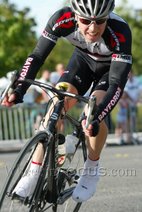by Coach Lang Reynolds
Of the 90 days separating the beginning of July from the end of September, I was home for just over ten of them. I raced in Oregon, Colorado, California, Utah, Virginia, Vermont, the District of Columbia, and of course Washington itself. Of the 20+ days of racing over the last three months, I didn’t win a single race, and I haven’t placed in the top 10 since March. It’s been a frustrating season. I’m a Cat 1 trying to get a rofessional contract, and while this much travel and racing is not strictly necessary in the quest to obtain a contract, I thought it was the best thing to do at the time.
Here at the end of the season, it’s easy to slip right into Whatever Comes Next, whether that is binge drinking or cyclocross (or both simultaneously, as they do in Portland), without taking an honest and focused look at the season just completed. What was instrumental in the goals that you did achieve, and what prevented you from reaching those that you didn’t?
To keep things short, I am just going to cover the second half of my season, which consisted of three big chunks of racing based around the schedule of my team, the Hagens-Berman LLP Elite cycling team. First came the week-long Cascade Classic in Bend, Oregon. Three weeks later we raced the National Championship Time Trial and Road Race in Irvine, CA and, after two days off, the five-day Tour of Utah. Following that I traveled to the East Coast twice for the Green Mountain Stage Race over Labor Day Weekend and some criteriums later in September. Additionally, in order to prepare for the Tour of Utah (where all the races were over 5,000 ft of elevation) I spent just over two weeks in Fort Collins, Colorado, training and racing at altitude.
So, what did I do wrong? First of all, the altitude training in Colorado to prepare for Utah ended up backfiring on me. I’ve learned that altitude is a tricky beast: in order to fully acclimate, one must spend several weeks (not just two) living at altitude. Additionally, because altitude forces you to work at a lower intensity (unacclimated athletes face a 10-20% drop in sustainable power), I left Colorado both unacclimated and less fit than I would have been had I been training at sea level. Coming off the intense Cascade Classic, my time in Colorado wore me down instead of giving me the boost I needed.
Secondly, I raced too much. Because I missed the month of May due to a knee injury, I tried to cram as much racing as possible into the end of the season. After Utah I tackled the 12-hour drive home in one sitting and raced all three local races that weekend. The next week I flew to Vermont for the four-day GMSR, came back for the Mt. Baker Hillclimb, then flew back for more crits on the East Coast. That amount of racing and traveling is not necessarily a bad thing (you have to be able to race and travel frequently if you want to ride professionally), but I should have taken the hint after mediocre performances at Nationals and Utah. I should have rested up, trained a little, and concentrated on just a couple of additional races. Or, I could have just called it a season and started training for Cyclocross.
I’m not happy about my performances over the last three months, but I did a lot of races that I’ve never done before and gained a lot of experience. I learned a lot and I am confident that I raced as hard as I could on each day of racing. I’m thankful to be part of a great team like HB Elite and more than anything I am looking forward to next year. By taking a look back and identifying what worked and what didn’t this year, I am one critical step closer to being prepared to make next year my best yet. One thing is for sure: I am staying away from altitude!
skip to main |
skip to sidebar
Follow us on Facebook
About Cycle U
Cycle University is an endurance sports coaching company with 2 retail bicycle shops founded by former pro cyclist Craig Undem based in Seattle, WA . Cycle U is run by experienced professional coaches focused on providing athletes, fitness enthusiasts, and hobbyists with the proper education, training and equipment to empower self improvement and personal excellence. Whether the focus is recreational, advanced, or professional level, the education and processes crafted by Cycle University provides the knowledge, practice & expertise to improve your athletic performance.
Services include: athletic coaching, bike fitting, fitness testing, skills clinics, private lessons, indoor InCycle classes, bootcamps, coaching consultations and teams for Triathlon, Cyclocross, Road, Non-Racing Performance and MTB.
Services include: athletic coaching, bike fitting, fitness testing, skills clinics, private lessons, indoor InCycle classes, bootcamps, coaching consultations and teams for Triathlon, Cyclocross, Road, Non-Racing Performance and MTB.
We also have 2 full service shops that sell Specialized and Felt Bicycles along with a full array of gear and clothing.
Going strong since 2004.
Cycle U's Mission Statement
It is our mission to significantly help people become healthier, stronger, safer, and faster, by using science, as well as our experience as coaches, experts and educators to maximize health and performance. We commit to make our community a healthier and better place through endurance sport.



